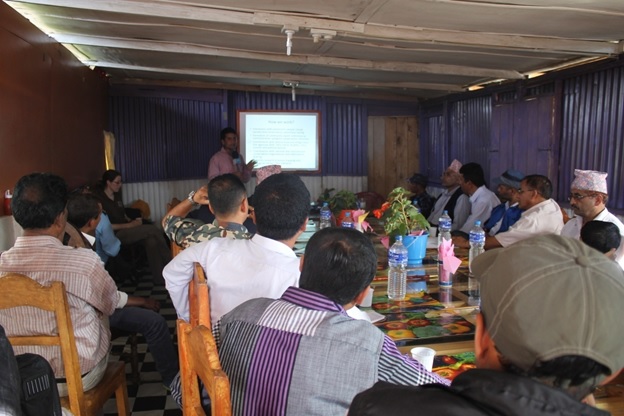Out of four Asian pangolins two species (Chinese pangolin Manis pentadactyla) and Indian pangolin (Manis crassicaudata) are found in Nepal. Chinese pangolins are distributed from the lower foothills to the middle mountains of Nepal while the Indian pangolins are reported from the Terai region of western Nepal. With support from the Zoological Society of London (ZSL) EDGE Fellowship programme, we have initiated a Chinese pangolin conservation project in the Eastern Himalayas of Nepal. The project, which was established in 2012, aims to collect baseline information on the ecology, status and distribution and specific threats facing the Chinese pangolin and generate support for their conservation. At present, lack of awareness of pangolins’ protected status among local communities, wildlife departments and law enforcement officers, together with the illegal trade in pangolin scales and habitat loss are major concerns for the long term survival of this unique species.
Our project aims to improve the situation through implementing awareness-raising activities, organizing community meetings, district and national level stakeholder workshops. We are also conducting outreach programmes among school students organizing essay competitions and erecting hoarding boards with pangolin conservation messages in major hamlets of the villages. We are collecting baseline information on pangolin status and threats through interview surveys, focus group discussions, transect surveys and camera trapping surveys. We are implementing our activities in a human dominated landscape (in two villages; Nangkholyang and Dokhu of Taplejung district) outside of protected areas in eastern Nepal (Fig 1).
map
One of our early successes was the formation of a Pangolin Conservation Committee (PCC) in Nangkholyang village. The PCC is working as a local level organization to control illegal activities in the village and to raise public awareness for pangolin conservation. A national level workshop on Chinese pangolin conservation was conducted in Kathmandu in August 2012 and district level stakeholder workshops were organized two times since implementation of this project. The workshops were helpful to communicate the Chinese pangolin conservation messages among government authorities, wildlife researchers, university students, security forces, local administration and concern line agencies to protect the species in its natural habitat and to enforce government law against illegal trade of pangolin scales.
Our project is setting the baseline for long-term monitoring of pangolins in the region. We are deploying 10 camera traps, which are placed randomly in front of pangolin burrows we suspect to be active. Camera traps are helpful to record the movement and activities of pangolins. One pangolin was caught on camera trap at 4:45 am in March 2013 in Nangkholyang in front of an approximately 7 day old burrow and another two photos of pangolins were taken at 2:35; 2:39 am in July 2013 in Dokhu village. Due to the steep terrain our transect surveys involve walking along terraces and human trails searching for pangolin burrows in forest and agricultural lands. 87 burrows were recorded in Nangkholyang and 152 burrows were recorded in Dokhu village. GPS locations of all burrows were overlaid on a digital map of the study area (Fig 1). ZSL’s EDGE Programme Manager, Ms. Carly Waterman, visited the field site in June 2013 and supported the team to collect social and ecological data effectively.
Villagers are asked a series of questions about pangolins before we start the awareness-raising activities and then asked the same questions afterwards. Our interview survey

EDGE Programme Manager, Ms. Carly Waterman discussing the project with EDGE Conservation Biologist during a visit in June 2013.
questionnaire was piloted in Nankholyang and was then undertaken in Dokhu village. A total of 65 households were interviewed from Nangkholyang and 72 from Dokhu village. We are planning to interview the same households again after our awareness campaign to quantify the impact of our conservation awareness programs.
For the next step we are planning to organize a training program for local youths and citizen scientists to equip them for Chinese pangolin monitoring in a regular basis at the villages. We will train them to fill out monitoring form, to handle GPS, camera traps and auto focus cameras.
by Ambika Prasad Khatiwada, Conservation Officer of National Trust for Nature Conservation in Nepal and member of the IUCN SSC Pangolin Specialist Group.




